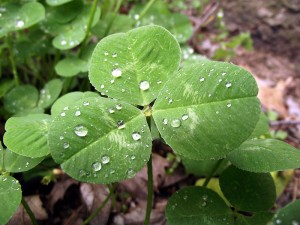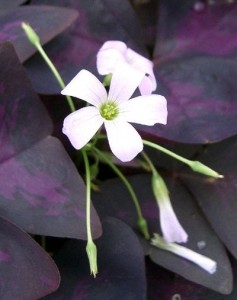10 Ways to Describe “Seamróga” (Shamrocks) in Irish Posted by róislín on Mar 8, 2014 in Irish Language
(le Róislín)
As we approach Lá Fhéile Pádraig (aka “Lá ‘le Pádraig” and “St. Patrick’s Day”), our thoughts naturally turn to “seamróga” (shamrocks). How many ways can we think of to describe them? We’ll try for at least ten in this blog. Maybe some readers will have some more suggestions.

seamróg agus an gnáthdhath (.i. glas) uirthi (pictiúr le supportstorm ag http://en.wikipedia.org/wiki/File:Trifolium_repens_Leaf_April_2,_2010.jpg)
A key thing to remember about using the word “seamróg” (a shamrock) in a sentence or phrase in Irish is that it becomes “an tseamróg” if you want to say “the shamrock.” The sound of the “t” and the initial “s” sort of blend together, forming an Irish “t caol” (slender “t”). It’s pronounced somewhat like the “tch” combination in English “match”(but not quite so “chuh-ish”) or like the “t” in the Irish-English pronunciation of “choons” (i.e. “tunes,” especially to be played in a seisiún ceol Gaelach). Here’s a quick review of the forms of “seamróg,” which you might remember from a previous blog (https://blogs.transparent.com/irish/an-tseamrog-the-shamrock/ of 10 Márta 2012):
an tseamróg [un TCHAM-rohgg], the shamrock
na seamróige [nuh SHAM-roh-igg-yuh], of the shamrock
na seamróga [nuh SHAM-roh-guh], the shamrocks
na seamróg [nuh SHAM-rohgg], of the shamrocks
And now here are ten phrases describing shamrocks, mostly quite straightforward, but with a few from off the beaten track. We’ll start with some basics and work our way up to some less typical phrases. The list will include both singular and plural examples. The singular examples will include lenition (séimhiú) of the adjective, if it begins with the usual round-up of lenitable consonants ( b, c, d, f, g, m, p, s, t). The plural examples will include a plural ending for the adjective, if it has one. How do you know whether an adjective has a plural ending? A full account would take at least another full blog, but here are some of the basics:
a) most adjectives ending in broad consonants add an “-a” at the end (mór / móra, bradach / bradacha); if the adjective ends in a slender consonant, it adds an “-e” at the end (maith / maithe)
b) adjectives ending in “-úil” change to “-úla” at the end: misniúil / misniúla, laethúil / laethúla
c) most adjectives that end in a vowel don’t change: fada / fada, corcra / corcra
Translations will appear below.
1. an tseamróg mhór
2. seamróg bheag
3. seamróg ghlas
4. an tseamróg fhliuch
5. seamróga áille

seamróg chorcra (http://en.wikipedia.org/wiki/File:Oxalis_triangularis6.jpg, grianghraf le “kenpei” in Osaka-fu, an tSeapáin)
6. seamróga corcra (admittedly, not the most typical color, but there is such a plant, though it’s not technically a shamrock, féach an nóta thíos)
7. seamróga cáiliúla
8. seamróg éaduilleach (improbable, I know, since what is a “seamróg” without its “duilleoga“?)
9. seamróg thrídhuilleach (beagán athluaiteachais ansin, ach cén dochar?)
10. seamróg smaragaide (an-chostasach!)
Bhuel, sin é, deich bhfrása faoi sheamróga. Ar mhaith leat ceann nó dhó a sheoladh isteach chuig an mblag? SGF — Róislín
Nóta faoi sheamróga corcra: The more I read about this plant, the more complex it becomes to pinpoint its botanical name. But, as I understand it, it’s either Oxalis triangularis or O. regnelli. If any botanist or shamrock fancier on the list can untangle the Latin names, it would be great if you could write in and let us all know. Either way, you might be interested in this very short video of an Oxalis plant (False Shamrock) in Stop Motion, at http://www.youtube.com/watch?v=Zg_8xIYAan8, posted by “alfredolouro.” The plant is responding to a solar spectrum lamp.
Aistriúcháin:
1. an tseamróg mhór, the large shamrock
2. seamróg bheag, a small shamrock
3. seamróg ghlas, a green shamrock
4. an tseamróg fhliuch [… lyukh, note the silent “f”], the wet shamrock (perhaps the whiskey-saturated one from the “Pota Pádraig,” or, well, I guess it could just be growing outside on an ordinary rainy day)
5. seamróga áille, beautiful shamrocks (“áille” is the plural of “álainn,” one of the irregular adjectives, which, by definition, wouldn’t fit the adjective system outlined above)
6. seamróga corcra, purple shamrocks (admittedly, not the most typical color, but there is such a plant, though it’s not technically a shamrock, féach an nóta thíos)
7. seamróga cáiliúla, famous shamrocks. It’s actually not so easy to find a “-úil” adjective that would typically modify a shamrock. A representative list of “-úil” adjectives for practice includes “flaithiúil,” “suimiúil,” and “misniúil,” the latter used, among other places, to describe “Bob an Garraíodóir” in the Irish version of “Muzzy,” which, btw, is now out of print and rather hard to come by. Another widely used “-úil” adjective is “áitiúil,” but how often do we really talk about “áitiúlacht na seamróg“?
8. seamróg éaduilleach, a leafless shamrock (improbable, I know, since what is a “seamróg” without its “duilleoga“?). Gotta love the technical translation of “éaduilleach,” which is “aphyllous.”
9. seamróg thrídhuilleach, a three-leaved shamrock (from trí + duilleach, which becomes “dhuilleach” in this compound word)
10. seamróg smaragaide (an-chostasach!), an emerald shamrock, i.e. a shamrock made of “smaragaid“(emerald) — very costly! But it could be an attractive piece of jewelry!

Build vocabulary, practice pronunciation, and more with Transparent Language Online. Available anytime, anywhere, on any device.




Leave a comment: